Abstract
Today, every industry is calling for their workforce to develop new skill sets due to the dynamic of technological change. Every country needs to prepare its Technical and Vocational Education and Training (TVET) sector for providing the required skills in the new industrial revolution (IR4.0). It is vitally important to assess TVET academics’ awareness and perceptions of IR4.0 and to ascertain how prepared they are to strategically and effectively manage work-based learning. Which factors have an influence on the situation? A survey based on 16 structured questionnaires was devised to measure the awareness, perception and preparation of 156 respondents, including TVET managers, teachers and students from different TVET institutions in Myanmar. Gender, major study, nature of employment and type of school were considered as influencing factors. Results were presented quantitatively for discussion and confirmed that gender, major study, nature of job and school influenced the awareness, perception and preparation of TVET academics. Strategic plans and reforms can be effectively introduced for future skills development in work- based learning scenarios which are relevant to major study, job nature and school nature.
Keywords: Technical education and training, Industry 4.0, Technological change, Technological literacy, Skills development
1 Introduction
Today, many industrial sectors have entered the fourth industrial revolution (IR4.0) with the power of 4G/5G internet and new technologies such as IoT (Internet of Things), AI (Artificial Intelligence), Cloud Computing, System Integration, Robotics, 3D Printing, Virtual Reality (VR), Argument Reality (AR), Cyber Security, Simulation, etc. In IR4.0, industrial sectors seamlessly connect their physical world to cyber systems in a variety of ways for greater efficiency and productivity. Changes in technology and working environments across different industrial sectors have created a demand for new types of jobs and, by extension, a workforce with the requisite skill set to master the new roles.
“In their journey to adopt IR4.0, each country is expected to encounter a number of challenges related to the skill level of their workforce” (BRICS Skill Development Working Group 2016). Thus, most countries have started to prepare knowledge and skills for the imminent industrial revolution, IR4.0. The level of preparation and readiness of each country for IR4.0 differs from one country to another and is dependent on many factors such as awareness, perception and current industrial demand, as well as government policy. There have been many surveys which have assessed the awareness, perception and preparation of corresponding societies for IR4.0.
Aygün et al. (2019) used a qualitative approach to measure the awareness level of 46 postgraduate students (master and doctoral students) from Istanbul University. The group included 21 male and 25 female students. Results showed that most respondents (more than 80%) had knowledge of “cyber security”, “simulation”, “virtual reality” and “3D printing”. However, only respondents from information technology were well acquainted with the concepts of Big Data and IoT. Only a few respondents from other major fields of study were familiar with these technologies. Major study is one identifiable factor which affects technology awareness. The authors recommended that undergraduate students’ awareness be measured on an international scale with a larger sample size and comparison between universities and countries.
The Ujakpa et al. (2020) study assessed the perception, awareness and preparedness of 24 university students in Namibia. The respondents, most of whom were 18 years old, came from the University of Namibia (UNAM) -14 students, the International University of Management (IUM) -5 students, and the Namibia University of Science and Technology (NUST) -5 students. 60% of respondents were aware of IR4.0. Results also revealed that 69.6% had worked with IR4.0 applications and 65.2% had competency to use IR4.0 applications, even though only 60% had known what IR4.0 actually is. The study’s authors admitted that the sample size was too small and recommended to increase it by including all levels of education (including primary and secondary school students). Level of education is clearly another factor influencing the awareness of IR4.0.
In Turkey, IR4.0 awareness of employees from 32 different businesses was surveyed by Ersoz et al. (2018). Results showed that IR4.0 awareness level was dependent on the sectors in which these businesses operated. The authors recognized that businesses/job variations ultimately led to varying levels of training that employees received. 54.65% of the employees were trained in IR4.0 and 43.35% were not trained. Results indicated that 27.08% of businesses had adequate knowledge of IR4.0. Ratnasingam et al. (2020) assessed the awareness and readiness of 778 large, medium and small-sized Malaysian companies in the furniture industry for IR4.0. Manufacturers of wood-based panel and metal furniture were found to be more aware of IR4.0 technologies than solid wood and leather furniture manufacturers. Respondents replied that robotics, CAD-CAM simulation and horizontal and vertical system integration were important IR4.0 technologies for them. This confirms that the nature of a business or the nature of the job is also a factor affecting the awareness of IR4.0.
Regarding readiness of business, Kohnová et al. (2019) analysed seven internal factors that support business and technology transformation towards IR4.0. These factors were (1) internal system of education/ knowledge management and development, (2)level of external partnerships in education and knowledge acquisition, (3) level of operational coordination–organization of projects, processes and tasks, (4) level of strategic alignment of development plans with existing resources, (5) availability of technologies and knowledge to develop new products/ services, (6) corporate culture in relation to promoting innovation and knowledge development and (7) the ability to identify and analyse trends and respond to them. Results showed that internal systems of education/ knowledge management and development were the most significant factors. Knowledge management and development is especially related to work-based learning. The authors recommended that it is important to educate employees and share knowledge through effective partnerships. This highlights the fact that external partnerships are essential to improving awareness of IR4.0, which is the first step of work-based learning.
According to the results from the Tinmaz and Jin (2019) survey in Korea, 14.7% of respondents were unaware of IR4.0 and 55.8% did not understand the applications of IR4.0, although they had heard of the concept. 4.1% have been working with IR4.0 and 3.1% had no preparation, although they knew of IR4.0. It was found that Korean students were less familiar with IoT, whilst 3D printing was the most well-known area. The authors noted that male students seemed more knowledgeable about and more interested in IR4.0 technologies than their female counterparts.
Similar observations were made in the study of Ismail et al.(2020).Based on a sample of 155 (85 male and 70 female) students, it was found that male students were better prepared to work in industry compared to female students in terms of attitude, leadership, communication and interpersonal elements, problem solving, knowledge levels and emotional intelligence. Gender is thus a potential factor which can influence the awareness, perception and preparation of IR4.0.
These findings make it clear that there are many factors that influence the awareness, perception and preparedness of academics and business people with regard to IR4.0. These factors include gender, education level, major study, nature of business/job, and external partnerships. Most surveys have been conducted with university students. Little or no attention has been granted to different academic levels in the TVET sector. The objective of this work is to assess awareness, perception and readiness of TVET students, teachers and managers with regard toIR4.0 in Myanmar by considering different influencing factors.
1.1 Problem statement and research question
TVET will play a significant role in the era of IR4.0. In anticipation of this development, the requisite IR4.0 skills for TVET are currently being prepared and developed in most countries, including Myanmar. In order to develop future TVET skills for IR4.0 effectively, it is important to have a strategy that takes account of the awareness, perception and readiness of TVET academics. The diverse nature of technical and vocational education and training depends on variables of gender, major study and job situations in relation to TVET academics and the types of school in which they work. The lack of information on these points in Myanmar leads to the following research questions:
- What levels of awareness, perception and preparedness for IR4.0 can be identified in Myanmar TVET students, teachers and managers?
- How do influencing factors (gender, major study, job nature, school nature) impact on awareness, perception and preparedness of academics for IR4.0?
2 Work-Based Learning Continuum
The work-based learning (WBL) continuum is a sequence of activities that starts with low-intensity experiences that begin to engage students in thinking about careers and gradually progresses into more in-depth, intensive experiences that include opportunities for hands-on learning (Johnson et al. 2017). Today, IR4.0 is an emerging technological concept that has been introduced in some industrial sectors such as manufacturing, healthcare, and logistics. Consequently, many employers are trying to transform their business model to align with IR4.0 on the basis of three factors; Process, People and Technology (PPT). Thus, it is important to encourage people in businesses to do work-based learning related to IR4.0.
Work-based learning consists of three main processes: awareness, exploration and preparation as shown in Figure 1. Work-based learning is important not only for students but also for teachers. It can expand teachers’ knowledge of employers in their region and of careers that maybe available to their students (Johnson et al. 2017).This study is related to measuring awareness, perception and preparation for IR4.0, which are the three main steps in work-based learning.
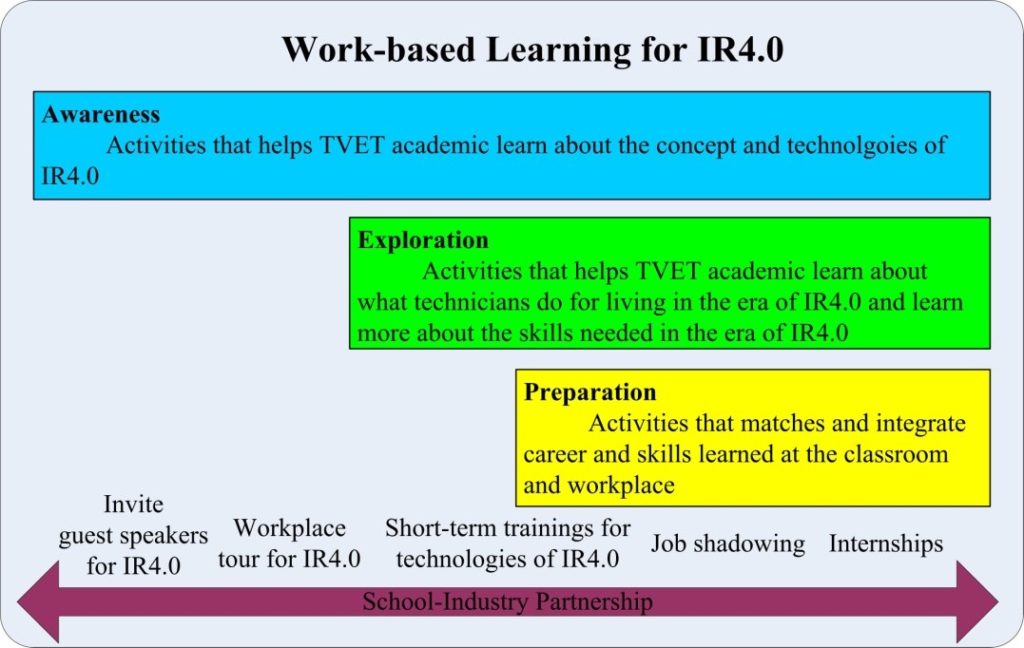
3 Methodology
3.1 Research model
There are indeed many factors that influence the awareness, perception and preparation of a country towards IR4.0. National policy and economy conditions are undoubtedly influential factors. For the purpose of this study, gender, major study, job nature, type or nature of school for academics were considered as influencing factors (independent variables) and awareness levels, perception and preparation of academics were considered as dependent variables in this research model as shown in Figure 2.
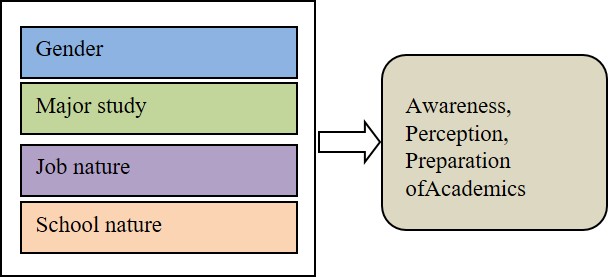
3.2 Research method
A survey approach was selected for this study as a means of exploring levels of awareness, perceptions and preparation of a number of academics. Survey research is usually undertaken through the use of questionnaires or interviews (Dawson 2009).The mono method, in which only structured questionnaires are applied, was used for data collection. Quantitative analysis of collated data was subsequently presented for discussion. Data collection was completed in a single phase of less than two months.
3.3 Population and samples
In survey research, it is important to provide detail of the sample used. In Myanmar, there are three different types of TVET institutions: Government Technical Institute (GTI) which offers diploma level, Government Technical High School (GTHS) which offers certificate level and Vocational Training School (VTS) which offers certificate level. There are a total of 3508 teachers and 70 school managers (principals) serving in 70 TVET institutions located all over Myanmar’s 15 regions. There are 24,918 students registered in the academic year of 2019-2000.
As samples, 17 principals of TVET institutions were selected to represent one region by at least one manager. At least five TVET teachers and three students from each region were invited to take the survey. 90 TVET teachers and 49 students participated in total. Table 1 shows detailed sample information. In most Myanmar educational institutions, the number of female teachers is twice that of male teachers. For this reason, the number of female samples is larger than the number of male samples. In terms of major study, Civil, Mechanical, Electrical and Electronics are four main major fields of study, whilst Industrial Engineering and Information Technology are only offered in a few GTI. Thus, the number of academics in Industrial Engineering and Information Technology is smaller than respondent numbers from other major studies. In Myanmar, there are 28 GTI, 35 GTHS and 7 VTS, hence the smaller number of respondents from VTS compared to the other institutions.
Table 1: Classification of respondents
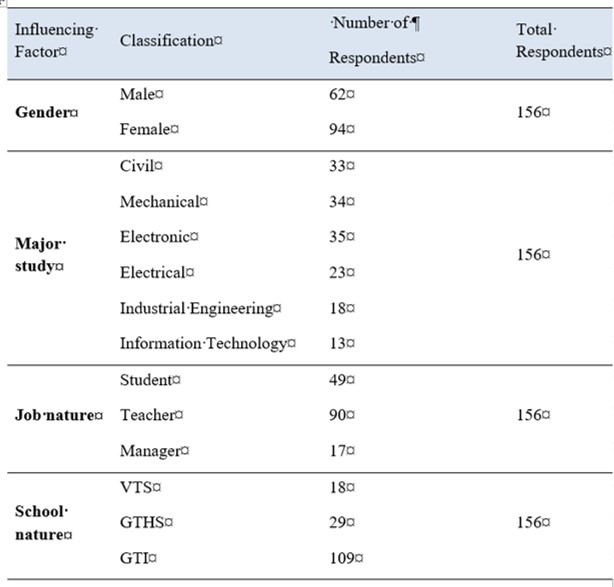
3.4 Instrument
A total of 16 structured questionnaires were created using Google survey forms and distributed to participants. The structured questionnaires used both closed-ended question types and open-ended question types. Some structured questionnaires were adopted from the work of Aygün et al. (2019). To avoid ethical issues, respondents’ permission was requested in advance and the names of respondents were omitted. As shown in Table 2, the questionnaires can be grouped into three categories.
Table 2: Structured questionnaires used in the survey
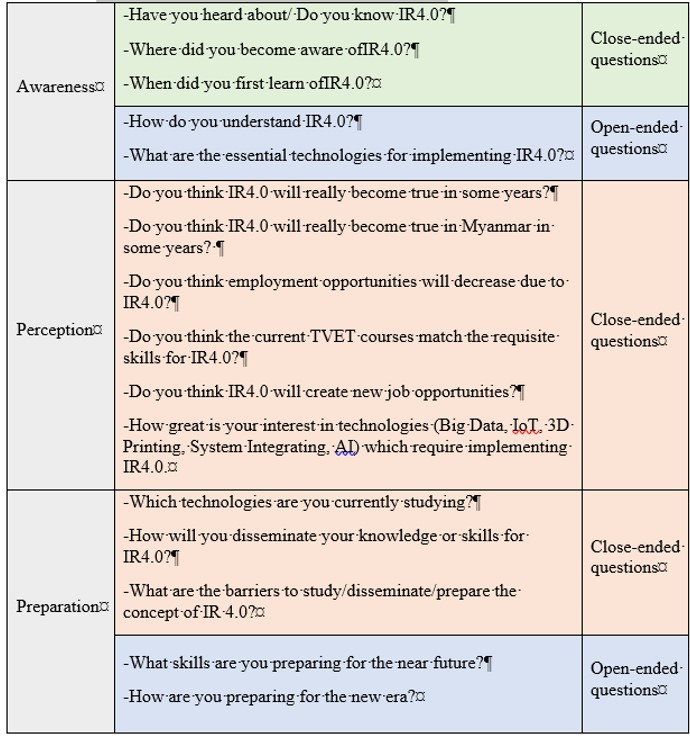
3.5 Data analysis
Count percentages and mean scores were used for quantitative analysis of the answers to closed-ended questions. These were calculated with the following equations.

Here, there are five rating scores. The score for “Strongly Agree” is 5, “Agree” is 4, “Normal” is 3, “Disagree” is 2 and “Strongly Disagree” is 1. Data analysis was conducted using Excel (software) spreadsheets.
4 Results and discussion
4.1 Awareness
Awareness levels of TVET academics are shown in Figure 3. Results indicated that 87.8% of Myanmar TVET academics have heard the term IR4.0, a larger number than expected. The result is similar to the findings of Aygün et al. (2019) which surveyed postgraduate students from Istanbul University. It is larger than the (60%) percentage observed by Ujakpa et al. (2020)for the University of Namibia (UNAM).
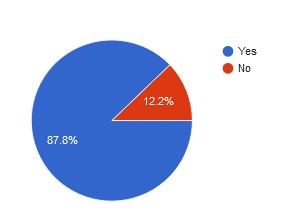
When answers to the open-ended question “How do you understand IR4.0?” were analyzed, it became apparent that some respondents had generally heard of technologies related to IR4.0 such as robot, AI, IoT, cloud computing technology, etc. but did not completely grasp the concept of IR4.0.Their answers were, at most, partially relevant.
“Latest manufacturing technology like robots and AI”
“The fusion of digitalization with traditional industrial processes”
“Fourth industry revolution, more automation, cloud computing and creating smart factories”
“Based on cloud technology and IoT technique (Internet of Things)”
“Digitalization and connection of all actors in the value process”
To another open-ended question, “What are essential technologies for implementing IR4.0?” most respondents answered:
“Big Data, AI, IoT, 5G”
“Internet, PLC and IOT”
“Internet of Things”
“The Internet of Things (basically), automated systems, robots”
“A little bit familiar with IoT”
It finds that most respondents are more familiar with IoT rather than other technologies. This contrasts with Tinmaz and Jin observations (2019), in which Korean students were less familiar with IoT.
Indeed, the concept of IR4.0 was first mentioned by BOSCH at the Hanover Trade Fair in 2011 (BOSCH Sanayi Ve Ticaret A.Ş. 2017). As depicted in Figure 4-(a), 46.2% of respondents became aware of IR4.0 in the last six months, 33.3% of respondents have known about it for a year. 13% of them have known about IR.40 since two years ago. Only 7.1% of respondents have known about it for three or more years.

The results in Figure 4-(b) reveal that 42.3% of TVET academics knew IR4.0 from the internet, 23.1% from educational talks, 9.6% from other sources (the workplace, for example), 8.3% from trainings, 6.4% from lectures, 5.1% from seminars. Most respondents read about IR4.0 on internet websites. Events such as educational talks, seminars and trainings for IR4.0 or advanced technologies (e.g. IoT) are rarely held in TVET institutions. Knowledge of IR4.0 is seldom shared in teachers’ lectures. Work-based learning (exploring the nature of work and learning required skills in the workplace) becomes particularly important. TVET teachers need to practice work-integrated learning and work-oriented teaching/learning processes.
4.2 Perception
As discussed in Kohnová et al (2019), there is still an intense debate in most countries on IR4.0 due to existing economic conditions, the ability to identify and analyse trends and how to respond to them. This study examined the perception of TVET academics with regard toIR4.0. Table 3 shows the mean scores of perception for Myanmar TVET academics. The highest mean score is 4.2, which shows the respondents are highly interested in IR4.0 technologies. Harnessing motivation to upgrade their skills for new technologies is a relatively easy proposition. It also appears that academics expect these technologies to find more practical applications in the near future.
Based on a mean score of 3.9, most academics agree that IR4.0 will become evident in most applications in some years, although it is currently at the very beginning in various industries, even from a global perspective. For Myanmar, the data shows that most TVET academics are in a natural position, whilst some respondents are less confident with regard to how IR4.0 will impact on Myanmar in the coming years.
Table 3: Mean score of perception of TVET academics for IR4.0
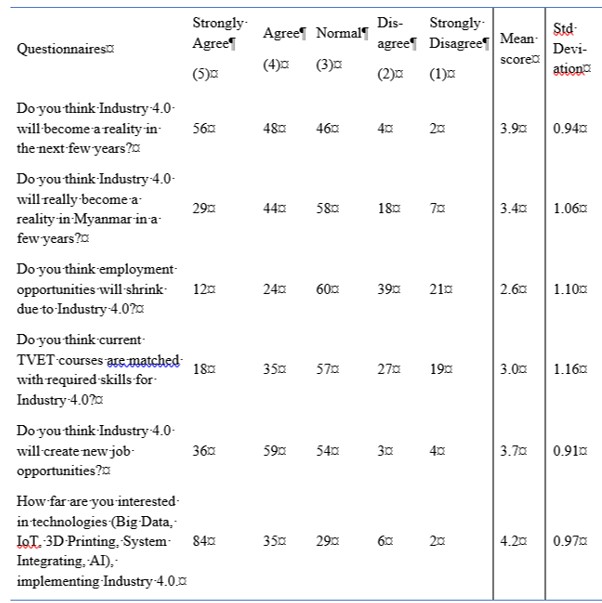
Since the mean score is only 2.6, TVET academics disagree with the statement “Employment opportunities will shrink due to Industry 4.0.”Their expectations do not suggest that employment opportunities will be reduced by IR4.0. At the same time, the results show that most respondents agree that IR4.0 will create new job opportunities. Few respondents had either positive or negative perceptions of current TVET courses.
Considering influencing factors, the detailed analysis of TVET academics’ perception of IR4.0 is shown in Table 4. Respondents generally agree that “IR4.0 will become evident in some years”. Differences in gender, major study, job nature and school nature appear to have little effect on perceptionasIR4.0 is currently trending as a global concept.
Table 4: Mean score of TVET academics’ perception of IR4.0
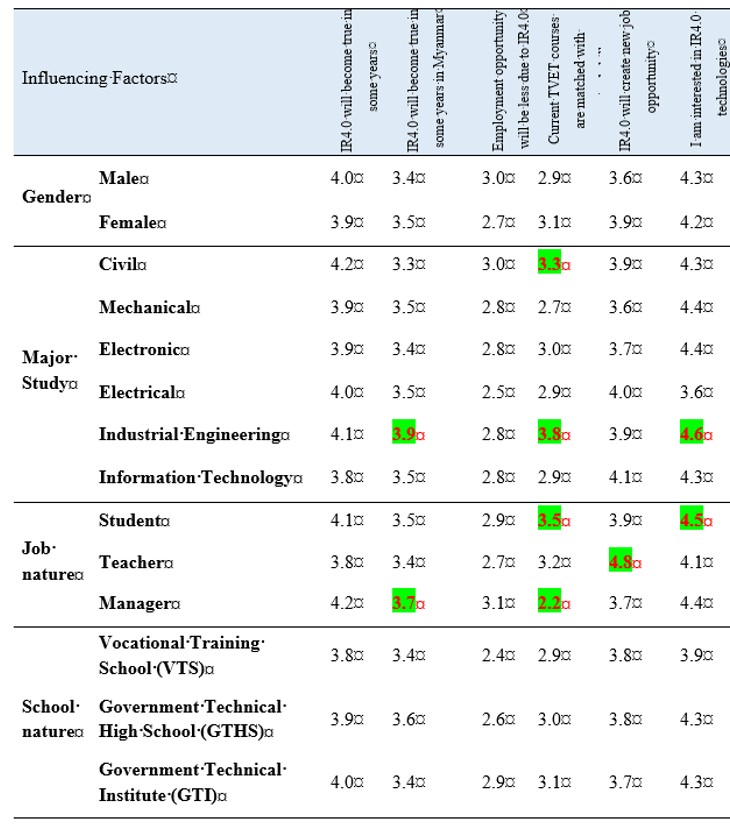
According to local conditions in Myanmar, TVET academics only agree slightly that “IR4.0 will become evident in Myanmar in some years”. This depends on major study and the job nature of TVET academics. Industrial Engineering respondents feel the same way, due to the fact that TVET academics in Industrial Engineering constantly experience the gradual growth of automation processes in Myanmar, more so than other major studies. TVET managers are confident that“IR4.0 will become evident in Myanmar in some years” as they have a better overview of global conditions and anticipate the positive growth of new technologies in Myanmar.
Most TVET academics disagree with the statement “Employment opportunities will be reduced due to IR4.0” so it can be claimed that TVET technicians do not generally expect any negative impact due to IR4.0. Perceptions do not vary depending on gender, major study, job nature or school nature.
TVET academics have different perceptions according to fields of major study and job nature with regard to the statement: “Current TVET courses are matched with required skills.” Academics from Industrial Engineering agree that their current course is individually matched with required skills in IR4.0, whereas respondents from other major studies such as Mechanical, Electrical and Information Technology do not feel that their current TVET courses match with the skills required in IR4.0. The curricula of Mechanical and Electrical major studies currently lack ICT skills and are in need of revision to promote work-integrated, work-connected and work-oriented teaching/learning.
Different perceptions between students and managers were highlighted in the survey. While students agree that current TVET courses are poorly matched with IR4.0skills, the managers do not. It is likely that students look at individual major studies, whereas managers look at as the overall picture.
All TVET technicians agree with the statement, “IR4.0 will create new job opportunities.” Female respondents have a stronger expectation of new job opportunities than the men. The field of major study does not show a significant impact on perceptions of job opportunities, indeed every major study has positive expectations in this regard. In terms of job nature, teachers have higher positive expectations for the emergence of new jobs in the era of IR4.0, more so than students and managers. Interest is high in every perspective, but it does also depend on major study fields and job nature. Respondents from Industrial Engineering shows a higher degree of interest than academics in other major study areas, as TVET academics from Industrial Engineering are more likely to encounter smart sensors, data transmission and automation, thus sparking their interest. Students are more curious about IR4.0 technologies than teachers or school managers and this shows in their pursuit of different technologies during their studies.
4.3 Preparation
Strategy, technologies, skills and barriers were surveyed to assess how prepared TVET academics really are for IR4.0. Figure 5 shows that Myanmar TVET academics study IoT more than any other field. PLC application is the second most popular, commonly used in smart factories. A high percentage of TVET academics have studied none of these advanced technologies.
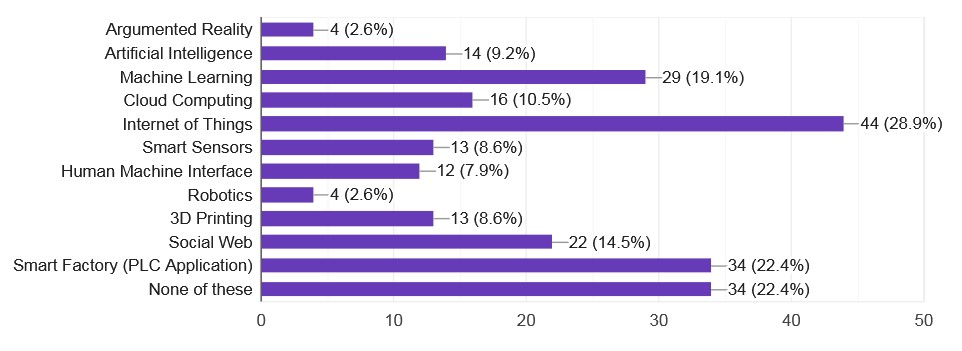
Machine learning is in third place, creating social web comes in fourth, followed by cloud computing in fifth one and AI in sixth. Smart sensors and 3D printing are in seventh spot, followed by others. An increasing number of engineering companies are providing IoT solutions, which could be one reason why IoT gains such a high level of interest and preparation among TVET academics. Furthermore, automation is a trending technology, popularly used in growing factories in Myanmar. PLC and sensors are essential components in automation systems, so TVET academics are currently keen to study PLC and smart sensors. One should note that TVET academics are learning these technologies in both formal and informal approaches for professional development. In the formal approach, they join curriculum-based trainings provided by Vocational Training Institutes (VTSs) and follow a specific curriculum. The informal approach is based on self-reliant learning at the workplace or at home. According to the detailed data shown in Table 5, it can be seen that a larger percentage of females are preparing for IoT technology, social web and PLC technologies than their male counterparts. Meanwhile, a higher percentage of males are focussed on machine learning, cloud computation, 3D printing technologies. In terms of major study fields, larger percentages of TVET academics from civil, industrial engineering and information technologies are preparing for IoT technology compared to other major studies. On the other hand, respondents from Electronic, Electrical and Industrial Engineering are engaging with PLC applications. Many respondents from Information Technology are preparing for social web technology
Table 5: Percentage of TVET academics who are preparing skills in different IR4.0 technologies
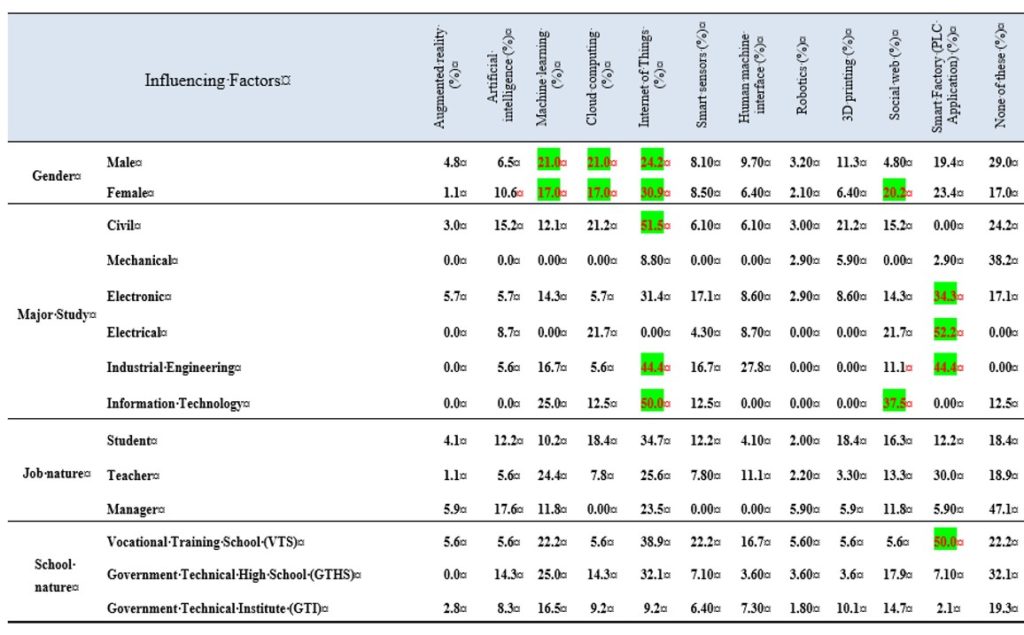
Respondents answered the open-ended question “What skill(s) are you preparing for the near future?” as follows:
“IT skills”
“Computer skills”
“English and Programming”
“Communication”
“21stCentury skills”
“Language skills”
These answers demonstrate that TVET academics understand both soft and hard skills are important in the era of IR4.0. ICT skills and communications are their key areas of focus. Responses to the question, “How are you preparing for the new era?” were as follows.
“Training course”
“On-line training, internet study”
“Self-learning (according to current conditions)”
“I am learning IoT and some sensors subjects from the internet”
“Watching technological videos”
It can be noted that most respondents rely on self-learning through video-lectures or the web. Some join physical training courses for IoT, Computer Programming, etc.
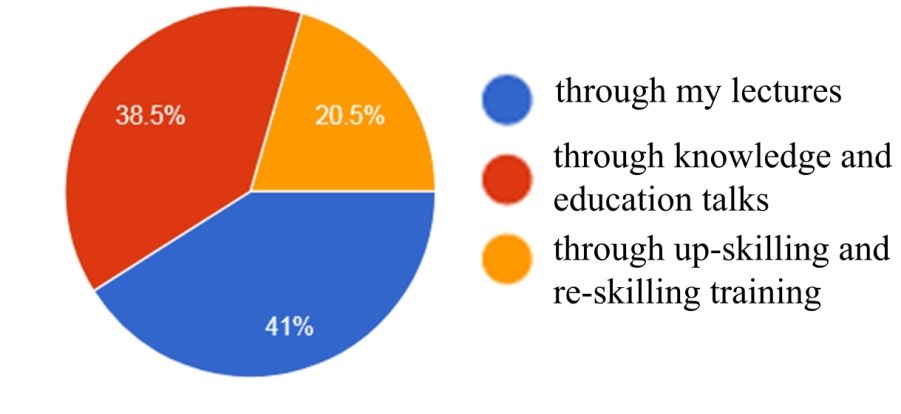
Figure 6 shows strategic plans of TVET managers and teachers for disseminating the concept of IR4.0. According to the results, teachers will share the IR4.0 concept and technologies by preparing special lectures or through reskilling and upskilling trainings. TVET managers also have plans to hold knowledge-based talks. It is likely that lectures and knowledge-based talks have more potential than upskilling or reskilling trainings. Trainings need more resources (experts, budget and materials) than lectures and talks, but they can provide more hands-on skills. The other potential approach for increasing knowledge of IR4.0 is work-based learning (e.g. factory learning or project learning) in which actual processes and practical work tasks can be observed or simulated. Work-based learning can increase not only knowledge of IR4.0 but also the requisite skills and competences through focussing on the simulation of work organization, work tasks and processes. Table 6 depicts detailed analysis of TVET academic strategies for the dissemination of IR4.0. Males are seen to be more interested in distributing knowledge and information of IR4.0 through talks, whilst a higher percentage of females plan to share knowledge through lectures. All major studies except f Information Technology choose the knowledge-based talks approach, whilst a significant percentage of TVET academics from Information Technology plan to share knowledge of IR4.0 through lectures. The approach of sharing through reskilling and upskilling trainings is clearly the least favoured choice due to the greater need for experts and resources. TVET managers are nevertheless keen to disseminate IR4.0 through reskilling and upskilling trainingsTable 6: .
Table 6: Strategies of TVET academics for the dissemination of IR4.0
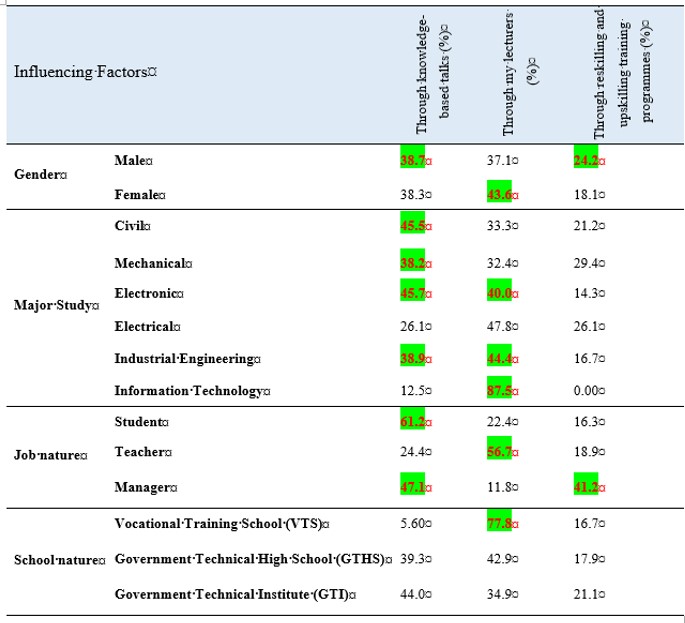
In Myanmar, short-term trainings for technologies such as 3D Printing, Argument Reality, Virtual Reality, Robotics Maintenance, etc. are still something of a rarity. One obvious reason is that these technologies do not feature in many applications in developing countries like Myanmar. This study also assesses the barriers to study/disseminate/prepare the concept of IR4.0.
Figure 7 depicts the barriers described by TVET academics. It can be seen that most respondents suggested that a lack of expertise with regard to IR4.0 is the greatest hurdle. It is a reasonable conclusion, as the number of industrial experts or academics who are fully expert in different IR4.0 technologies is still low. The Department of TVET of Myanmar is therefore trying to nurture expert trainers for IR4.0 by collaborating with ASEAN countries and European organizations such as GIZ.

Another reason they mentioned is that factories or employers are less interested, as awareness of IR4.0 in Myanmar is still in its early stages. Many manufacturers are still less interested in the transformation from IR2.0/IR3.0 to IR4.0 due to different conditions, such as existing infrastructure, investment costs, human resources, digital literacy and so on.
The third barrier is “No IR4.0 related jobs/industries”. It is clear that, in most countries, there are no obvious IR4.0 industries and/or jobs at this juncture. These will evolve in the next few years in most countries.
The fourth barrier relates to insufficient support to study/disseminate/prepare IR4.0. A lot of materials are freely and easily available to study about IR4.0, but considerable effort and resources are required to set up effectively organized and systematic training. This could be the reason why TVET technicians stress the need for support. The fifth barrier is “Not enough information”. TVET technicians need to access information for conferences, knowledge-based talks and trainings for IR4.0 which should be available to everyone. The sixth barrier is that some respondents are less confident with regard to the reality of IR4.0 or they may think it is not yet necessary in Myanmar’s current state of development. This is also one of the factors impeding the move to study/disseminate/ prepare IR4.0.
5 Conclusions
In this work, a survey was conducted with a total of 156 respondents -students, teachers and school managers – aiming to explore the awareness levels, perceptions and preparation of Myanmar TVET academics with regard to IR4.0 by considering influencing factors such as gender, major study, job nature and school nature. 16 closed-ended and open-ended questionnaires were deployed. Based on the observations gleaned from the survey, the following conclusions can be drawn.
- More than 87% of TVET academics have heard about IR4.0, even though some respondents may not properly understand it to any great degree. Thus, different approaches are still needed to create awareness of IR4.0 among Myanmar TVET academics.
- Most respondents learned about IR4.0 from internet sources within the last six months. More knowledge-based talks and reskilling or upskilling trainings should be arranged in TVET institutions.
- Most managers knew about IR4.0 through knowledge-based talks. Others learned about it on the internet. TVET managers should devise more plans to share and increase awareness of IR4.0 and develop curricula to promote work-integrated, work-connected, work-oriented teaching/learning.
- Myanmar TVET academics agree that IR4.0 will become a reality in Myanmar in a few years. They do not believe that on that IR4.0 will have an adverse effect on employment opportunities.
- While respondents from Mechanical and Electrical Engineering feel their current TVET courses do not match with the required skills for IR4.0, Industrial Engineering respondents believe that their current courses are individually matched with required IR4.0skills. This perception depends on the field of major study. TVET courses in Myanmar are currently being reviewed and GTHS and GTI courses being improved.
- IoT and PLC are the most prioritized technologies being prepared by Myanmar TVET academics. A higher percentage of females are preparing for IoT technology, social web and PLC technologies, males tend to focus on machine learning, cloud computation, 3D printing technologies. Development of social webs is highlighted primarily interested by Information Technology respondents due to its relevance to their studies. Preparation for IR4.0 is clearly dependent on gender and major study areas.
- All types of TVET institutions in Myanmar favour the knowledge-based talks approach rather than lectures or reskilling/upskilling trainings. However, TVET institutions also consider work-integrated, work-connected and work-orientated learning as strategies for more effective and faster distribution.
The small sample size of students and the fact that only questionnaires were used in the survey must be acknowledged as limitations of this research. Interviews should be added to reach a more complete understanding of the situation and to explore perceptions more thoroughly. Data can display some variations, depending on the sample size in relation to the population. In further works, consideration should be given to teaching/ learning processes, curriculum design, and the effect of industrial development, economic conditions and government policies on awareness, perception and preparation forIR4.0.
References
Aygün, D., Yılmaz, I. G., & Sati, Z. E. (2019). Industry 4 Awareness: A Research on Postgraduate Students. In: 6th International Management Information Systems Conference, 239-247. Istanbul: Kadir Has University.
BRICS Skill Development Working Group. (2016). Skill Development for Industry 4.0.Whitepaper. Munich: Roland Berger GmbH.
BOSCH Sanayi Ve Ticaret A.Ş. (2017). A brief history of Industry. Online: https://www.sanayidegelecek.com/en/sanayi-4-0/tarihsel-gelisim/ (retrieved 30.07.2021).
Dawson, C. W. (2009). Projects in Computing and Information Systems: A Student’s Guide, Second Edition. Essex: Pearson Education Limited.
Ersoz, F., Merdin, D., & Ersoz, T. (2018).Research of Industry 4.0 Awareness: A Case Study of Turkey. In: Economics and Business, 32, 1, 247-263.
Ismail, M. E. et al. (2020). Gender analysis of work readiness among vocational students: A case study. In: Journal of Technical Education and Training, 12, 1, 270-277.
Johnson, L., White, R., Charner, I., Cole, J., & Promboin, G. (2017). FHI 360 Work Based Learning Manual: A How to Guide for Work-Based Learning. Durham: FHI 360.
Kohnová, L., Papula, J., & Salajová, N. (2019). Internal factors supporting business and technological transformation in the context of Industry 4.0. In: Business Theory and Practice, 20, 20, 137-145.
Ratnasingam, J. et al. (2020). Assessing the awareness and readiness of the Malaysian furniture industry for Industry 4.0. In: BioResources, 15, 3, 4866-4885.
Tinmaz, H. & Jin, H. W. A. (2019).A preliminary analysis on Korean university students’ readiness level for Industry 4.0 revolution. In: Participatory Educational Research, 6, 1, 70-83.
Ujakpa, M. M., Osakwe, J. O., Iyawa, G. E., Hashiyana, V., & Mutalya, A. N. (2020). Industry 4.0: University Students’ Perception, Awareness and Preparedness-A Case of Namibia. In: 2020 IST-Africa Conference, 1-10.




